VT Dendro Lab Notes
Japanese maple
Aceraceae
Acer palmatum
Leaf: Opposite, simple, orbicular in outline, 2 to 5 inches long, serrated margin, 5 to 7 deeply palmate lobes, some cultivars so deeply lobed that leaf appears compound; color highly variable depending on cultivar, commonly deep red.
Flower: Species is monoecious; inconspicuous, small, red to purple, in terminal hanging clusters, appearing in mid to late spring.
Fruit: Double samara, 3/4 to 1 inch long, divergent (90 degrees) wings, reddish brown, maturing in late summer and a bit persistent.
Twig: Slender, glabrous, red or green; buds broadly conical, green or red, base of bud hidden by tan, fuzzy fringe.
Bark: Smooth, light gray, with a somewhat fluted trunk.
Form: A small tree, 10 to 25 feet in height, round crown, typically multistemmed or branches low. Some cultivars have drooping branches.
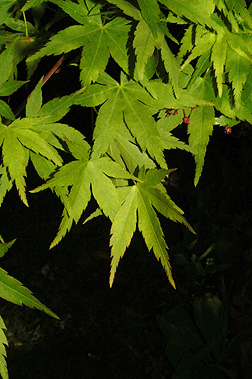


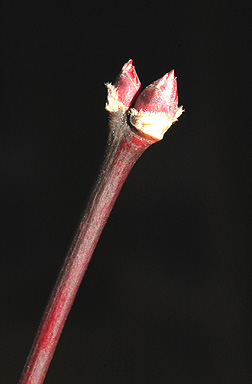
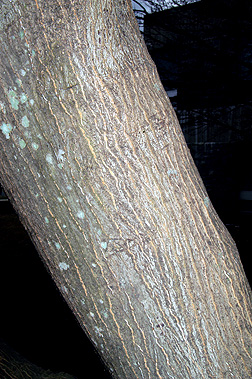
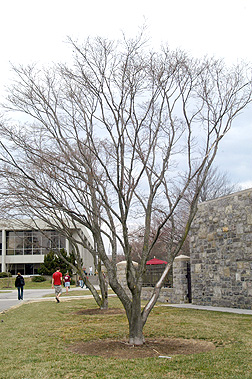

Notes:
VT Dendro Lab Notes
American holly
Aquifoliaceae
Ilex opaca
Leaf: Alternate, simple, evergreen, elliptical, 2 to 4 inches long, spiny toothed margin, thickened and leathery, shiny dark green above, much paler below.
Flower: Species is dioecious; dull green-white, male flowers on 3 to 7 flowered cymes, female flowers are solitary with a pleasant odor, appearing in late spring.
Fruit: Berry-like drupe, red, rarely yellow when ripe, 1/4 inch in diameter, containing ribbed nutlets; maturing in fall and persisting on tree into winter.
Twig: Slender, with rust-colored pubescence; buds small reddish brown, pointed.
Bark: Light gray and smooth regardless of size.
Form: A small tree to 40 feet, with a thick crown and pyramidal form, usually with branches to the ground.


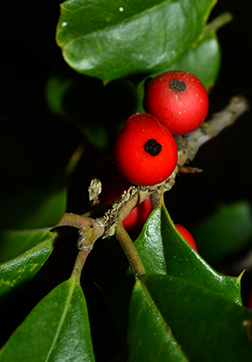




Notes:
VT Dendro Lab Notes
baldcypress
Cupressaceae
Taxodium distichum
Leaf: Linear and small, 1/4 to 3/4 inch long, generally appearing two-ranked. When growing on deciduous branchlets the leaf-deciduous branchlet structure resembles a feathery pinnately (or bi-pinnately) compound leaf; green to yellow-green.
Flower: Males in drooping, long panicles; females are subglobose, have peltate scales, and tend to occur near the end of branches.
Fruit: Cones are composed of peltate scales forming a woody, brown sphere with rough surfaces, 3/4 to 1 inch in diameter; cones disintegrate into irregular seeds.
Twig: May be deciduous or not; non-deciduous twigs are slender, alternate, brown, rough, with round buds near the end of the twig; deciduous twigs are two-ranked, resembling pinnately compound leaves.
Bark: Fibrous, red-brown but may be gray where exposed to the weather; old, thick bark may appear somewhat scaly.
Form: A large tree with a pyramid-shaped crown, cylindrical bole, fluted or buttressed base and often with knees.







Notes:
VT Dendro Lab Notes
northern white-cedar
Cupressaceae
Thuja occidentalis
Leaf: Evergreen, scale-like, on main shoots, 1/4 inch long with long points. Lateral shoots are flattened, 1/8 inch long with short points.
Flower: Species is monoecious; solitary, females green with 4 to 6 scales; males are green tipped with brown and globose.
Fruit: A cone, 1/2 inch long, oblong, borne upright on the branches, scales are leathery, red-brown and rounded, with a small spine on the tip.
Twig: New growth is green and scale-like, turning brown, occurring in very flattened foliar sprays.
Bark: Fibrous, red-brown, weathering to gray; diamond-shaped patterns are usually apparent.
Form: A small to medium sized tree shaped like an arrowhead - a pyramid with a broad base and a small, round top, often with several main trunks.







Notes:
VT Dendro Lab Notes
Leyland cypress
Cupressaceae
xHesperotropsis leylandii
Leaf: Evergreen, fine, scale-like foliage, arranged in decussate pairs, individual leaves 1/16 to 1/8 inch long, green to bluish-green above and below, arranged in flat sprays.
Flower: Species is monoecious; not showy, males small (1/8 inch) reddish brown terminal cones; females sightly larger, round, yellow-green.
Fruit: Round, small cone, 1/2 to 3/4 inch diameter, brown, rarely fruits.
Twig: Flattened or quadrangular branchlets.
Bark: Reddish brown, scaly when young, later developing gray weathered strips.
Form: Medium sized tree reaching 60 to 70 feet in landscape, narrow, oblong crown.







Notes:
VT Dendro Lab Notes
red mulberry
Moraceae
Morus rubra
Leaf: Alternate, simple, broadly ovate to roughly orbicular, 3 to 5 inches long, serrate margin, highly variable in that they may have no lobes or be highly dissected into lobes; green above with a rough scabrous texture, paler and fuzzy below.
Flower: Species is usually dioecious; small, pale green; male flowers are hanging catkins, 1 to 2 inches long; females are 1 inch long catkins, both appearing in late spring.
Fruit: Resembling blackberries, cylindrical, 1 to 1 1/4 inches long, fleshy multiples of drupes, each containing a small seed, maturing in summer.
Twig: Slender, zigzag, green changing to red-brown, sometimes pubescent; buds are covered with brown-margined overlapping scales; leaf scars shield-shaped and somewhat sunken; silvery-white filaments present when broken.
Bark: Gray-brown and quite irregular with long, scaly ridges. Younger trees are often orangish, especially when wet.
Form: A small tree to 60 feet in height, with a short trunk that typically branches low.







Notes:
VT Dendro Lab Notes
Fraser fir
Pinaceae
Abies fraseri
Leaf: Flattened needles, 3/4 inch long, blunt or notched at the end, shiny dark green above and silvery below. Needles generally more dense than on the very similar balsam fir.
Flower: Species is monoecious; males yellow to purple; females in upper crown, inconspicuous, purple.
Fruit: Resinous cones are upright, 1 1/2 to 2 1/2 inches long, cylindrical, green to purple, with pointed, toothed bracts protruding from the cone scales; scales are deciduous with seed dispersal in fall.
Twig: Yellow-green, later turning gray; buds round, reddish brown, resinous; leaf scars are flat and rounded.
Bark: Silvery gray-brown, smooth except for resin blisters, largest stems may become a bit scaly.
Form: Fraser fir is a small to medium size tree to 80 feet, with a very narrow, spire-like crown.







Notes:
VT Dendro Lab Notes
Scots pine
Pinaceae
Pinus sylvestris
Leaf: Evergreen needles, 1 1/2 to 3 inches long, with two stout, twisted needles per fascicle, blue-green with distinct stomatal bands.
Flower: Species is monoecious; males cylindrical, yellow, in large clusters along twigs; females oval, yellow-green to purple.
Fruit: Cones are ovoid, 1 1/2 to 2 1/2 inches long, yellow-brown in color and slightly stalked; umbo is somewhat armed, with a blunt spine; apophysis resembles a pyramid, particularly on basal scales; maturing in the fall.
Twig: Moderately stout, green when young, changing to yellow-brown to olive-brown with large orangish, narrowly ovoid buds.
Bark: Orange to orange-brown and scaly or peeling when young; later developing irregular gray or red-brown ridges and furrows. Upper crowns always show orange peeling bark.
Form: A medium sized tree reaching up to 90 feet tall, often with a twisted or poorly formed trunk (depending on origin of seed). Young crowns are rounded; older crowns become round-topped.







Notes:
VT Dendro Lab Notes
Japanese black pine
Pinaceae
Pinus thunbergii
Leaf: Evergreen needles in fascicles of 2, 3 to 5 inches in length, dark green and stout, persisting 2 to 4 years.
Flower: Species is monoecious; males reddish-yellow, in clusters near branch tips appearing in early spring; females reddish and egg-shaped.
Fruit: Woody egg-shaped cone, 2 to 3 inches long, 1 1/2 to 2 inches wide, light brown in color, unarmed or with a very minute prickle.
Twig: Light brown, glabrous, in later years turning grayish; buds are large, quite prominent and light reddish brown.
Bark: Dark gray, breaking into irregular, rough scaly plates.
Form: Irregular, wind swept form reaching up to 80 feet tall; in the landscape they often resemble a large Bonzai tree.







Notes:
VT Dendro Lab Notes
Douglas-fir
Pinaceae
Pseudotsuga menziesii
Leaf: Evergreen, single needles that lack woody pegs or suction cups, yellow-green to blue-green, 3/4 to 1 1/4 inches long, tips blunt or slightly rounded, very fragrant.
Flower: Species is monoecious; males oblong, red to yellow, near branch tips; females reddish, with long bracts, occurring near branch tips.
Fruit: Very distinctive, 3 to 4 inches long with rounded scales. Three-lobed bracts extend beyond the cone scales and resemble mouse posteriors. Maturing in late summer.
Twig: Slender and red-brown, with long, sharp, pointed, red-brown buds.
Bark: Smooth and gray on young stems, becoming thickened, red-brown with ridges and deep furrows.
Form: A pyramidal crown that is somewhat open and self-prunes poorly. Stems are characteristically straight.







Notes:
VT Dendro Lab Notes
royal paulownia
Scrophulariaceae
Paulownia tomentosa
Leaf: Opposite, simple, heart-shaped and quite large, 5 to 12 inches long, typically quite velvety, green above and paler below; leaves on younger trees will often show course serrations or even lobes.
Flower: Large, showy, upright clusters of purple flowers; individual tube-like flowers are 1 1/2 to 2 inches long, very fragrant and appearing in mid-spring.
Fruit: Oval capsule, 1 to 1 1/2 inches long, filled with numerous (1,000s) small seeds; capsules initially sticky and green, later turning brown and dry, persistent.
Twig: Stout, light brown, numerous lenticels, leaf scar nearly circular, bundle scars arranged in a circle, pith is hollow in the second year; terminal bud lacking, lateral buds small.
Bark: Thin, grayish brown with shallow fissures.
Form: Rounded crown, heavy, clumsy branches, reaches 50 feet tall, 2 feet in diameter.







Notes:
VT Dendro Lab Notes
English yew
Taxaceae
Taxus baccata
Leaf: Evergreen needles, single, spirally arranged but appearing 2-ranked on shaded branches, 1 inch long, long pointed tip, needles typically angled upward forming a V-shape on branch, dark green and shiny above, yellow or pale green below with 8-10 stomatal rows.
Flower: Species is dioecious; male flowers are small, round, and yellow and are borne on the undersides of the leaves; female flowers are solitary.
Fruit: Naked ovoid seed 1/4 inch long, surrounded by a bright red, fleshy aril, maturing in late summer, persistent through fall.
Twig: Light green in color, turning brown after several years; buds green with scales keeled.
Bark: Dark, usually red-purple, and scaly or somewhat peeling.
Form: Small tree or large shrub up to 60 feet tall with many limbed boles and a short trunk.







Notes:
VT Dendro Lab Notes
Siberian elm
Ulmaceae
Ulmus pumila
Leaf: Alternate, simple, elliptical to ovate, 1 to 2 1/2 inches long, singly serrated margin, nearly an equilateral base, dark green and smooth above, paler and smooth below.
Flower: Species is monoecious; small, pale green clusters occurring in early spring before leaves.
Fruit: Thin, wafer-like samara, nearly round, notched at top, 1/2 inch in diameter, initially pale green, later turning light brown when ripe in spring.
Twig: Slender, slightly zigzag, grayish tinged with green; buds are quite small (1/8 inch), dark reddish-gray, round, flower buds are considerably larger.
Bark: Irregularly furrowed, light grayish brown, often streaked with lighter stains caused by bacterial wetwood and associated "bleeding".
Form: A medium sized tree reaching up to 70 feet tall; typically a very bad looking tree due to considerable limb breakage and sprouting along the trunk.







Notes:


























































































